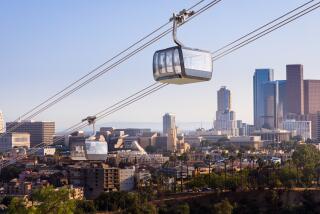Los Angeles OKs outlines of downtown football stadium deal
In the most significant step toward bringing NFL football back to Los Angeles since the city lost out on an expansion team more than a decade ago, the City Council on Tuesday approved the outlines of a $1.5-billion deal to develop a new downtown stadium and major wing of the Convention Center.
The unanimous vote gave city leaders a rare chance to seize on a major economic development after years of slashing payrolls, scaling back services and watching helplessly as the real estate market dried up. And it came at a time when business leaders and trade unions are desperately seeking ways to jump-start a local economy plagued by double-digit unemployment.
“It is a very important project at a very tenuous economic time,” said Carol Schatz, executive director of the Central City Assn., a downtown business group and a leading backer of the project.
“We’re bringing the NFL back.... We’re going to get millions more in additional development, and that means millions more in tax revenue. On this one I have to ask: What’s not to like?”
The vote is a victory for politically influential developer Anschutz Entertainment Group, which overcame concerns from some council members and activists that the city was rushing into a risky deal that could compound its budget woes. In the end, city negotiators shifted more financial risk to AEG and promised a full examination of the project’s environmental impacts.
Approval of the deal framework puts AEG in a better position to deliver on its plan to open the 72,000-seat stadium in five years and show the NFL that the company has overcome political obstacles, said AEG Chief Executive Tim Leiweke. “It sends a very strong message to the NFL owners. We did it. We were unanimous,” he said.
More detailed negotiations will continue for months, but AEG can now step up efforts to pursue a team from another city — a linchpin of the development agreement. “It’s big for the leaders there to make the commitment they have,” said Dallas Cowboys owner Jerry Jones, who serves on the NFL’s stadium review committee.
City Administrative Officer Miguel Santana, a key city negotiator, said, “We’re serious about this.”
AEG is already working on state legislation to limit the type of legal challenges —- including one it fears from backers of a competing stadium in the City of Industry — that could be filed against the project on environmental grounds. Such lawsuit restrictions can provide builders and lenders greater certainty about large projects but are also highly controversial.
“What we are asking for is protection from frivolous lawsuits from those who are trying to get a competitive advantage or those who are just trying to destroy the process,” Leiweke said.
The Raiders pulled up stakes in 1995. Four years later, L.A. almost secured an expansion team for the Los Angeles Memorial Coliseum, only to see the ownership group outbid by a Houston billionaire. Later efforts also fizzled when proposals involving downtown, Carson and the Coliseum failed to gain traction.
Stadium boosters contend that this proposal is different, delivering more than 20,000 new jobs — 6,320 of them permanent — while freeing up the money the city needs to replace the oldest section of its Convention Center. That facility lags behind those in San Francisco, San Diego and Anaheim in event bookings.
“I really believe that it’s going to happen,” said Councilman Bernard C. Parks of securing an NFL team.
Of the challenges still ahead, the most difficult for Phil Anschutz, the billionaire owner of AEG, could be securing an NFL franchise. The league has no intention of expanding beyond the current 32 teams, so Anschutz must reach a deal with an existing owner to relocate to L.A.
The relocation would have to be approved by a three-fourths vote of the 32 owners. The league is unlikely to give away access to L.A., the nation’s second-largest media market, so any deal would almost certainly include a transfer fee, possibly in the hundreds of millions of dollars.
But sports agent Casey Wasserman, who brought the downtown stadium idea to AEG, said Tuesday’s action shows the NFL that city officials can find common ground with the private sector. “This is a solution that really does work for everybody. It puts the pieces together to bring the NFL back,” he said.
Developers of the competing City of Industry stadium, which also has preliminary local approvals, gave no indication that they were backing off, saying Tuesday that their project would generate “more money, jobs and long-term success for the region and the NFL” than the AEG proposal.
“We are more active than ever and are currently working with the league, owners and teams to bring a franchise back to Los Angeles,” said John Semcken, vice president of Majestic Realty.
The L.A. stadium would be AEG’s third major project on the southern edge of downtown. The council approved the L.A. Live entertainment complex in 2005 and Staples Center more than a decade ago.
AEG, which has poured money into the election campaigns and ballot measures of the city’s political leaders, overcame the skepticism of a trio of council members who voiced fears about the financial details.
“I’ve looked at this and I’ve studied it and I’ve argued against it, as you have all heard,” Councilman Paul Krekorian told his colleagues. “And I have become convinced that … the risks are minimal, if not nonexistent.”
Under the proposal, the city would issue $275 million in bonds, money that would allow for the demolition and reconstruction of the Convention Center’s West Hall. AEG would then build the stadium, to be known as Farmers Field, on the former site of the West Hall.
Revenue from both projects — including sales taxes, property taxes, and parking taxes — would be used to pay off $195 million in bonds. AEG would be on the hook for the remaining $80 million in bonds, and if it defaulted, the city would have the power to foreclose on L.A. Live, city analysts said. A vote on a final stadium deal between AEG and Los Angeles is slated for May.
In the seven months since AEG’s Leiweke announced plans for a stadium, council members have heard a constant drumbeat of support from members of the city’s construction trade unions. Those workers have shown up at council meetings week after week, telling of their ongoing financial woes and describing the stadium as a lifeline.
“We’ve got members coming to us on a regular basis saying that their unemployment is running out, that they don’t know how they’re going to pay their rent, their utilities,” said Sergio Ramos, an organizer for Laborers’ Local 300, who showed up for Tuesday’s vote with about 30 union members in orange vests.
Despite such support, critics continued to warn that the project would flood downtown with additional traffic and leave too much money on the table for AEG.
Management consultant Quentin Fleming, who has attended several stadium hearings, said the city also should have demanded a 50-50 split of any revenue that exceeds AEG’s currently projected investment return. “The economics are there,” Fleming told the council. “Is the political will?”
Leiweke said that reopening the deal to look at profit sharing would not “inspire confidence” with the NFL. “Let’s not revisit deals that have already been done,” he said.
More to Read
Get our high school sports newsletter
Prep Rally is devoted to the SoCal high school sports experience, bringing you scores, stories and a behind-the-scenes look at what makes prep sports so popular.
You may occasionally receive promotional content from the Los Angeles Times.








